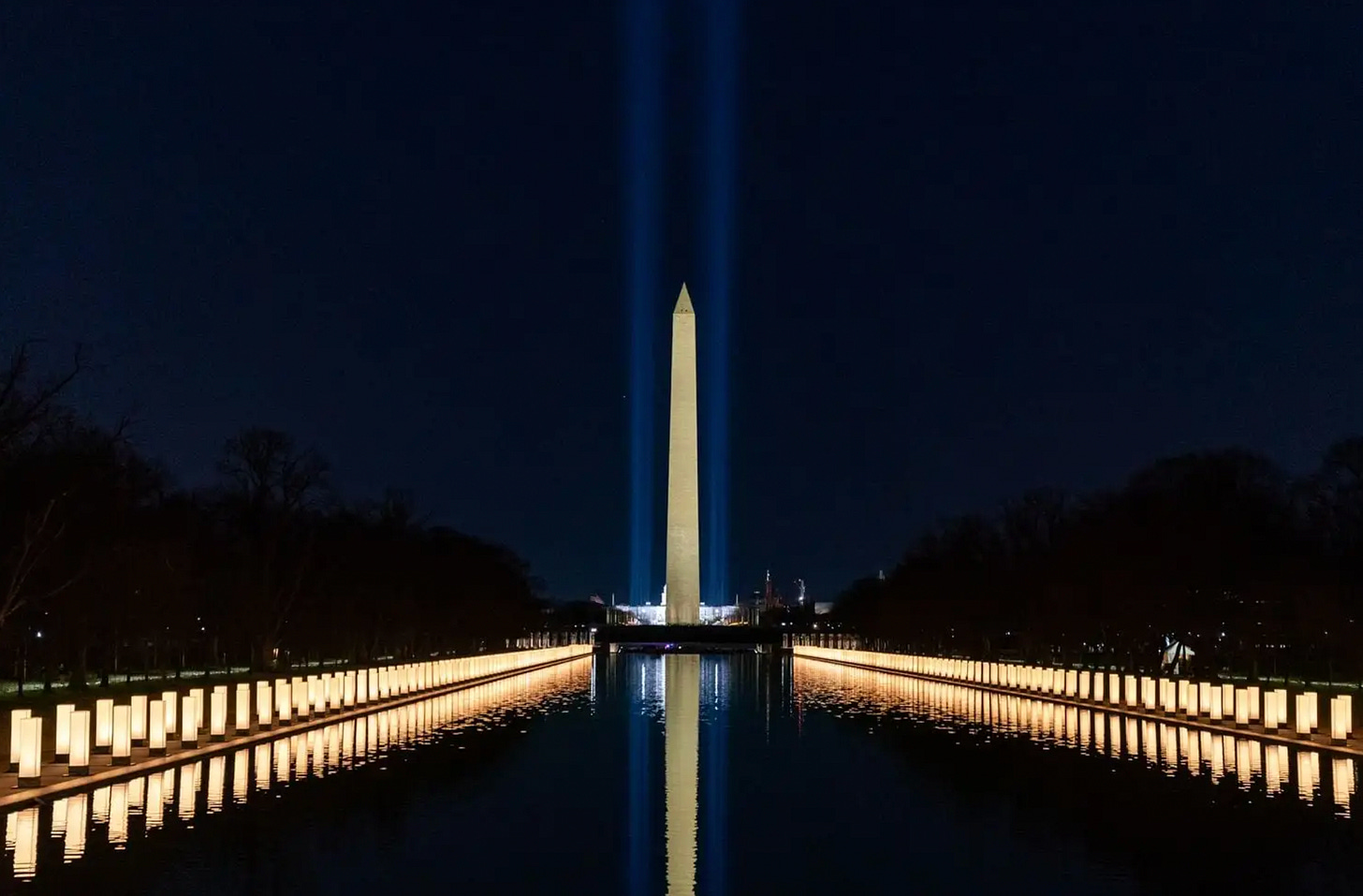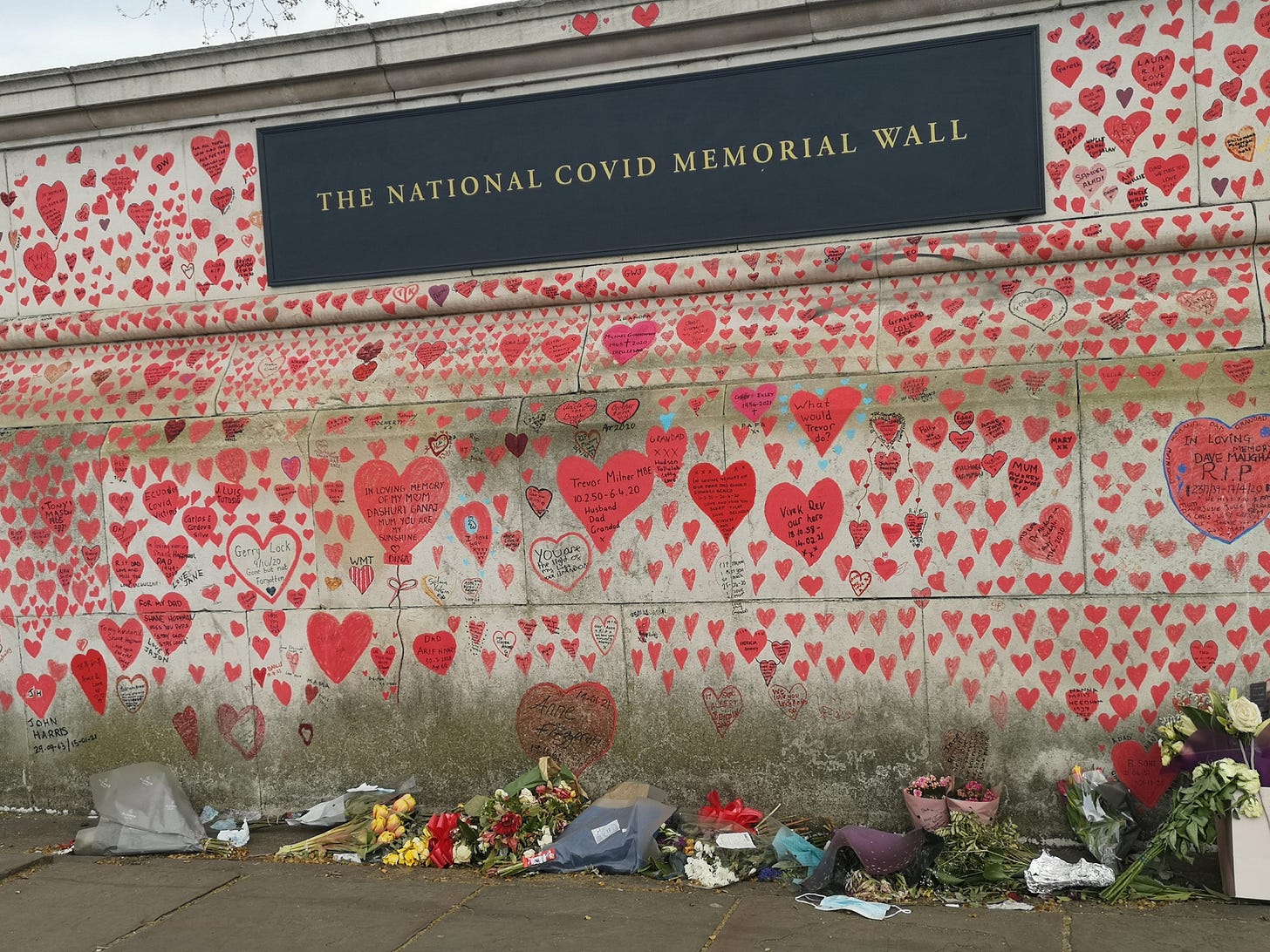Drinking the waters of Lethe
Despite killing more than six million people worldwide, Covid-19 is already in danger of being forgotten. Why are so we bad at commemorating pandemics?
On the eve of his inauguration as the 46th president of the United States, Joe Biden held a candlelit vigil at the Lincoln Memorial for victims of the coronavirus pandemic. By January 2021, some 400,000 Americans had died of Covid-19 and after one of the most rancorous presidential elections in history Biden wanted to signal a change of political tone. Standing in front of the Reflecting Pool on the Mall, surrounded by 400 lights representing the US casualties of the pandemic, Biden urged Americans to put their differences aside.
“To heal we must remember,” he said. “Between sundown and dusk, let us shine the lights in the darkness along the sacred pool of reflection and remember all whom we lost.”
Since then, there have been further moments of silence – most notably on 12 May 2022, when the US passed the milestone of one million Covid deaths, prompting Biden to order the stars and stripes to be flown at half-mast on public buildings. But, at time of writing, there is no permanent US national memorial to Covid-19. Nor, despite numerous proposals by artists, architects and bereaved groups, has Britain seen fit to commission an official memorial to the pandemic either (to date, the only country which is planning to mark this shared global experience is Uruguay).
It is as if, rather than looking into the Reflecting Pool and remembering, we have collectively drunken the waters of Lethe.
Why this should be the case is puzzling given the global sweep of Covid-19 and the way the coronavirus has disrupted social life and traditional bereavement practices. According to a study by the National Academy of Sciences, for every Covid death, approximately nine surviving Americans will have lost a grandparent, parent, sibling, spouse or child. Using the current estimate of 1.1m US deaths, that’s equivalent to nearly 10m grieving Americans. In Britain, where 200,000 people have died of Covid, that translates into 1.8m people mourning the death of a loved one. Worldwide, the bereaved could number 600 million.
Numbers of this order are difficult to grasp. As Albert Camus writes in his 1947 novel, The Plague, they are “just a mist drifting through the imagination”. One of the functions of memorials is to provide a canvass for the imagination so that the individual and collective nature of these losses can be visualised and preserved in public memory. In the case of the Vietnam War memorial in Washington DC this is achieved by listing the names of all 58,000 who died or went missing in the conflict. By contrast, the Cenotaph in Whitehall makes no reference to individuals who perished in the First World War but derives its mnemonic power from the symbolism of an empty tomb.
But while wars are endlessly memorialised in Western culture, it is relatively rare to come across a memorial to victims of a pandemic, much less a monument recalling the heroism of health workers who have perished on the front lines of humanity’s recurrent battles with pandemic pathogens. For example, despite killing more than 50 million people worldwide, there are no contemporary memorials to the 1918-1919 “Spanish influenza” pandemic anywhere in Europe or North America. Nor, with a few notable exceptions, such as the pandemic window at the Church of St Augustine with St Phillip in Whitechapel, London (see below), have those who perished in the Spanish flu been memorialised since. Memorials to the 14th century Black Death and the outbreaks of plague and cholera that swept Europe in the seventeenth, eighteenth and nineteenth centuries are similarly rare.

Why this should be the case is unclear but appears to be connected to the fact that epidemics and pandemics are natural events largely outside of human agency and control and do not lend themselves to compelling moral narratives. As the memory studies scholar Astrid Erll puts it in a recent collection interrogating “the forgotten and unforgotten” Spanish flu of 1918-1919: “Who are the perpetrators if the flu is caused by mutations of a string of RNA? What could the moral of the story be if victims are claimed randomly?”
Another consideration is that while wars are able to draw on a familiar suite of symbols and repertoires, pandemics have not been sufficiently mediated in our culture, leaving them outside what the historian Rheinhart Koselleck calls the “space of experience”. Without such pre-mediation, collective memory struggles to find a consistent shape or form, hampering the ability to incorporate ‘lessons’ for the prevention of future pandemic crises into the present.
Arguably, one reason we were so poorly prepared for Covid-19 and the lockdowns that attended the pandemic is that we had failed to pay sufficient heed to how societies had resorted to similar measures at other times and places. Quarantines are a tried-and-tested response to outbreaks, one that has changed little since 1377 when Dubrovnik banned travellers from plague-infested areas entering the city. Yet when, in January 2020, we saw pictures from Wuhan of patients clamouring for medical treatment, we could not imagine that quarantines and lockdowns would be needed to prevent hospitals in Europe or North America being similarly overwhelmed.
We need to remember that experience to avoid making the same mistake in future. This is particularly important at a time when we are beset by multiple new crises, including a war in Europe, and politicians appear eager to draw a line under the coronavirus pandemic even as we endure a debilitating fifth wave of infections. But it is difficult to remember, let alone heal, when societies remain divided over the lessons of the mortal first and second waves and cannot agree whether public health measures, such as testing and face masks, are needed going forward.
In June, Britain began the process of the learning lessons of Covid-19 by convening a public inquiry into the government’s handling of the pandemic. Among those giving evidence to the inquiry’s chair, Baroness Heather Hallett, will be Covid-19 Bereaved Families for Justice, the activist group responsible for the “National Covid Memorial Wall” on London’s South Bank. Comprised of 200,000 red hearts – one for every British victim of the pandemic – the wall has become a pilgrimage site for bereaved families from across the UK but is not officially recognised by the government. This reluctance can be explained in part by its positioning directly opposite Parliament, making it a symbol for those angry about what they view as the government’s bungled response to the pandemic and a focal point for protests about the recurrent breaches of the lockdown regulations by Boris Johnson and other members of his Cabinet.
In the United States, the artist Suzanne Brennan Firstenberg’s installation, In America: Remember on the National Mall in Washington DC last October provided a similar focal point for grieving Americans angered by Trump’s pandemic miscues but has now been dismantled (you can see people’s responses to installation, which featured 700,000 white flags, in Jamie Meltzer affecting documentary Not Even For a Moment Do Things Stand Still). And although New York last year unveiled a permanent memorial to sanitation workers who perished in the pandemic, so far few other US cities have followed suit.
In a recent report for the UK’s Arts and Humanities Research Council, Dr David Tollerton, a memory studies expert at the University of Exeter, argued that the principal challenge for any country contemplating a permanent memorial to the coronavirus is to find a way of encapsulating the scale of national losses while allowing space for the remembrance of individual experiences of death and bereavement.
The problem is that public reflection on the past two-and-a-half years of Covid-19 and the lockdowns that accompanied the pandemic, cannot help but navigate what Tollerton calls “a complex (and sometimes controversial) relationship between state and non-state agency”. At the same time, motivations for public reflection vary and there is “sometimes uncertainty about what it is that we are reflecting upon and remembering”. The result, concludes Tollerton, is that “while many want to keep memorialisation wholly non-political” in practice this may be “difficult to achieve”.
The British government’s failure to recognise the National Covid Memorial Wall is a case in point, reflecting its embarrassment over “Partygate” – memories which Johnson’s successor will presumably also be keen to avoid. Little wonder that some have been calling for a memorial that allows people of all points of view and faiths to come together to mourn the loss of loved ones in a tranquil, politically neutral space. This is the thinking behind St Paul’s Cathedral’s plan for a new portico in its North Transcript. Following a crowdfunding campaign supported by the Daily Mail, St Paul’s has raised £2.7 million for the memorial and anticipates that construction of the new inner porch will be completed in early 2024.
No doubt some will object that in the midst of a pandemic that appears to be far from over it makes little sense to begin a national conversation about how Covid-19 should be remembered and in what form. But as the experience of the Hillsborough stadium and Grenfell fire disasters demonstrate, building consensus is difficult and if we wish to do justice to national tragedies, even ones sparked by a random virus, we have to be willing to have frank and honest conversations about who is to blame and to what extent. The best chance of Covid-19 avoiding the same fate as the Spanish flu is to begin that process now.
A shorter version of this article was published on Engelsberg Ideas on July 19, 2022.



